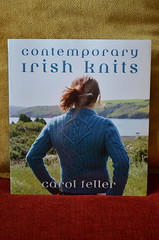First, the facts:
Title: Contemporary Irish Knits
Author: Carol Feller
Published by: Wiley, 2011
Pages: 152
Type: Patterns.
Chapters:
1. Introduction
2. Kerry Woollen Mills
3. Cushendale Woollen Mills
3. Donegal Yarns
4. New Directions: The Hand Dyers
5. Appendices
The In-Depth Look:
What calls to you when you think of Irish knits?
Do you picture cables? Do you love the interplay as they weave in and out, twist around as they climb?
Perhaps it’s the tradition that draws you in? The history of the sweater shapes and where the cable patterns came from?
Maybe it’s the yarn itself that attracts you–the knowledge that it is produced in the same way it’s been made for generations.
Or, heck, maybe you just want to make warm handknits for everyone in your family.
Either way–you must check out this book.
Twenty patterns in good, Irish wool. Sweaters, shawls, hats, gloves … the usual suspects … designs and sized for everyone. Boys, girls, men and women. Some of them are traditional gansey-type shapes, while some (like the Aran skirt or the girl’s yoke cardigan) are more modern. All of them, though, have a firm sense of their roots in their interpretation of “contemporary Irish.”
Nowhere is that more clearly seen than by the visits to the Irish woollen mills highlighted in each section. The author writes, “Ireland has a long history of yarn milling, which was once a very large industry. Due to rising costs and reduced demand, all but a few mills are now closed. …Yarn from Irish sheep creates coarse but hardwearing and durable wool. … For me, a sense of heritage and inspiration comes from the remaining Irish mills. Specifically, I am impressed by the ways in which they move forward–by listening to the knitting community and by innovating their manufacturing processes–while retaining the treasures of the past like the distinctive flecks, technically called ‘nepps,’ of Donegal tweed.”
I admit I’ve always been fond of Aran-styled, Irish-inspired knitwear. I adore the intricacies of Celtic knots and interweaving cables, so it’s no surprise that I was ready to love this book. Luckily, though, it does not disappoint. The patterns are updated without losing track of their roots. The look at the Irish wool industry (as well as some of the traditions) is interesting without getting bogged down by dry historical facts.
The illustrations are lush and evocative, while still giving good looks at the actual knitwear. There are charts and schematics. The patterns are listed in the table of contents and in the index, so they’re easy to find. And even though each pattern is designed for a specific manufacturer’s yarn, there’s a list of reasonable substitutes at the back in case you can’t find the authentic stuff.
All in all, this is a charming book. The kind that makes me wish I was Irish.
You can get your copy at Amazon.com.
Want to see bigger pictures? Click here.

This review copy was kindly donated by Wiley. Thank you!

